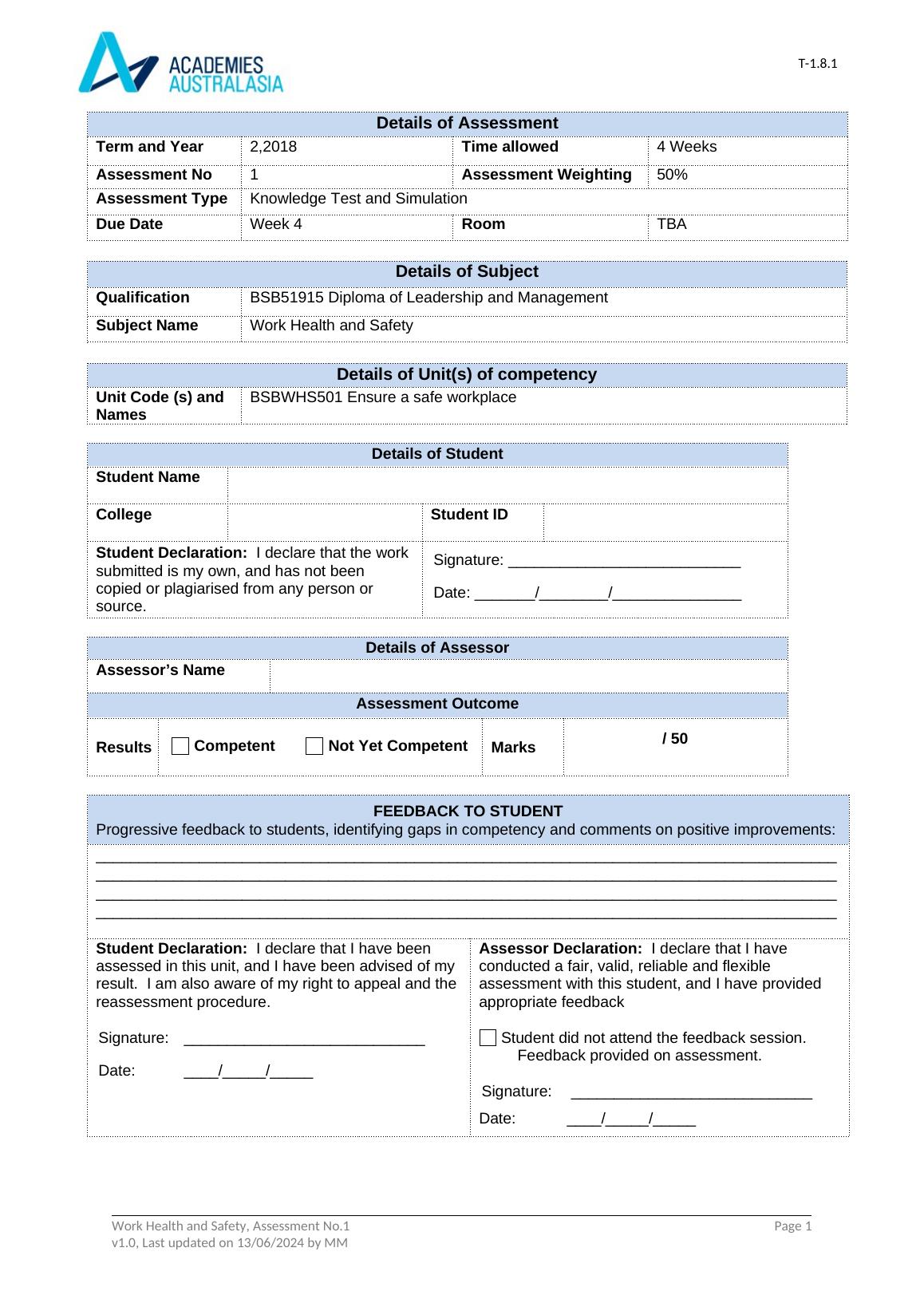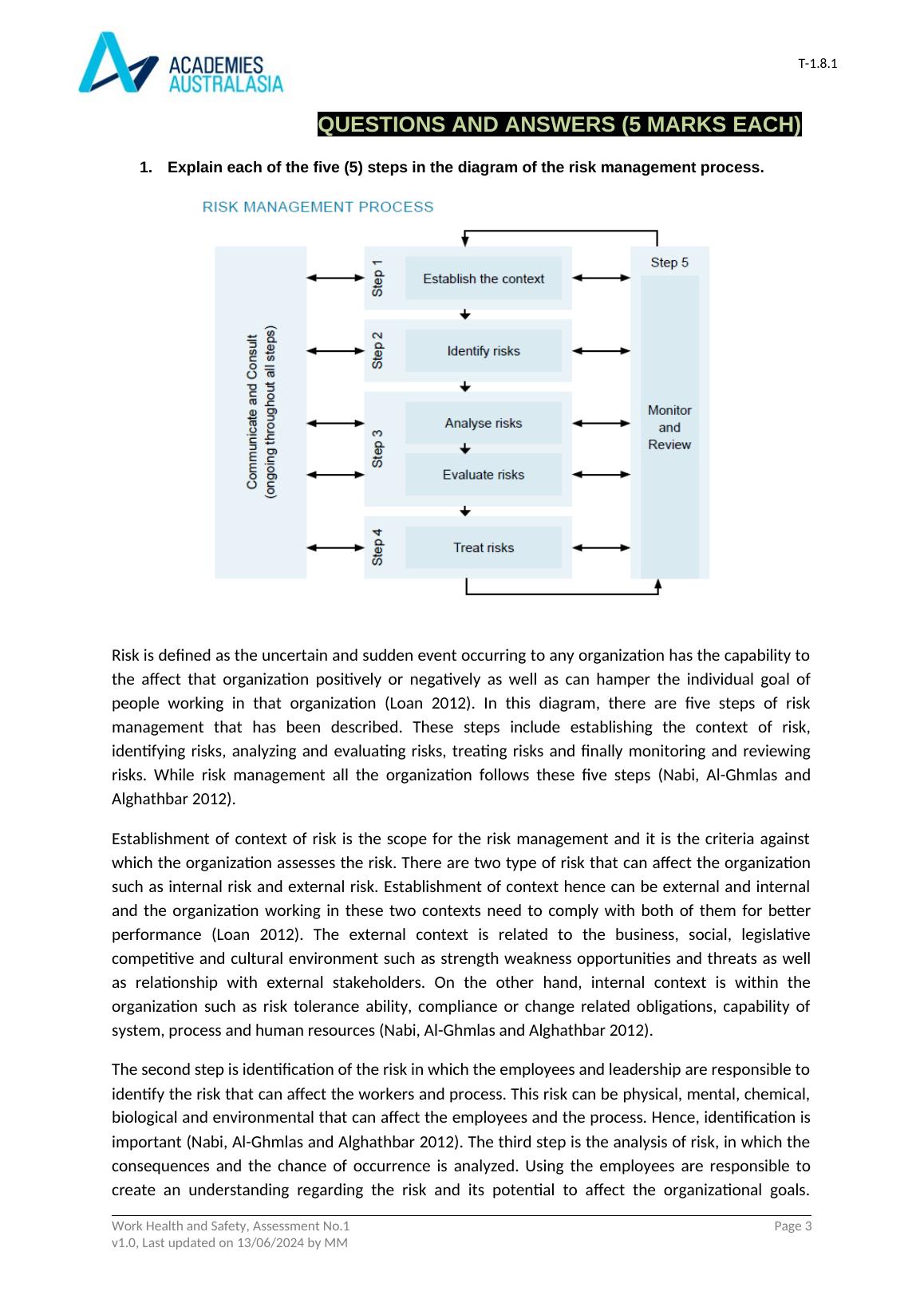BSBWHS501 : Ensure a Safe Workplace
Added on 2021-06-15
12 Pages4410 Words41 Views
T-1.8.1Details of AssessmentTerm and Year2,2018Time allowed4 WeeksAssessment No1Assessment Weighting50%Assessment TypeKnowledge Test and Simulation Due DateWeek 4RoomTBADetails of SubjectQualificationBSB51915 Diploma of Leadership and ManagementSubject NameWork Health and SafetyDetails of Unit(s) of competencyUnit Code (s) and NamesBSBWHS501 Ensure a safe workplaceDetails of StudentStudent NameCollegeStudent IDStudent Declaration: I declare that the work submitted is my own, and has not been copied or plagiarised from any person or source.Signature: ___________________________Date: _______/________/_______________Details of AssessorAssessor’s NameAssessment OutcomeResultsCompetent Not Yet CompetentMarks / 50FEEDBACK TO STUDENTProgressive feedback to students, identifying gaps in competency and comments on positive improvements:________________________________________________________________________________________________________________________________________________________________________________________________________________________________________________________________________________________________________________________________________________________Student Declaration: I declare that I have been assessed in this unit, and I have been advised of my result. I am also aware of my right to appeal and the reassessment procedure.Signature: ____________________________Date: ____/_____/_____Assessor Declaration: I declare that I have conducted a fair, valid, reliable and flexible assessment with this student, and I have provided appropriate feedback Student did not attend the feedback session. Feedback provided on assessment.Signature: ____________________________Date: ____/_____/_____Work Health and Safety, Assessment No.1Page 1v1.0, Last updated on 15/06/2021 by MM

T-1.8.1Purpose of the AssessmentThe purpose of this assessment is to assess the student in the following learning outcomes:Competent (C)Not Yet Competent(NYC)identify and detail relevant WHS Acts, regulations and codes of practicedescribe the hierarchy of risk control and how it is applied in the workplacespecify relevant WHS organisational policies, procedures, programs and practicesexplain hazard identification and risk-management processesspecify in-house and WHS legislative reporting requirementseffectively identifying hazards, and assessing and controlling risks using the hierarchy of risk controlidentify requirements for and request expert WHS adviceestablish, implement, maintain and evaluate effectiveand compliant participation arrangements for managing WHS including identifying duty holders, identifying and approving the required resources anddeveloping and implementing a training programensure organisational WHS complianceestablish, implement, maintain and evaluate procedures for a WHS management systemAssessment/evidence gathering conditionsEach assessment component is recorded as either Competent (C) or Not Yet Competent (NYC). A student can only achieve competence when all assessment components listed under “Purpose of the assessment” section are recorded as competent. Your trainer will give you feedback after the completion of each assessment. A student who is assessed as NYC (Not Yet Competent) is eligible for re-assessment.Resources required for this AssessmentComputer with relevant software applications and access to internetWeekly eLearning notes relevant to the tasks/questionsInstructions for StudentsPlease read the following instructions carefullyThis assessment has to be completed In class At homeThe assessment is to be completed according to the instructions given by your assessor.Feedback on each task will be provided to enable you to determine how your work could be improved. You will be provided with feedback on your work within two weeks of the assessment due date. All otherfeedback will be provided by the end of the term.Should you not answer the questions correctly, you will be given feedback on the results and your gaps in knowledge. You will be given another opportunity to demonstrate your knowledge and skills to be deemed competent for this unit of competency. If you are not sure about any aspects of this assessment, please ask for clarification from your assessor.Please refer to the College re-assessment for more information (Student Handbook).Work Health and Safety, Assessment No.1Page 2v1.0, Last updated on 15/06/2021 by MM

T-1.8.1QUESTIONS AND ANSWERS (5 MARKS EACH)1.Explain each of the five (5) steps in the diagram of the risk management process. Risk is defined as the uncertain and sudden event occurring to any organization has the capability tothe affect that organization positively or negatively as well as can hamper the individual goal ofpeople working in that organization (Loan 2012). In this diagram, there are five steps of riskmanagement that has been described. These steps include establishing the context of risk,identifying risks, analyzing and evaluating risks, treating risks and finally monitoring and reviewingrisks. While risk management all the organization follows these five steps (Nabi, Al-Ghmlas andAlghathbar 2012). Establishment of context of risk is the scope for the risk management and it is the criteria againstwhich the organization assesses the risk. There are two type of risk that can affect the organizationsuch as internal risk and external risk. Establishment of context hence can be external and internaland the organization working in these two contexts need to comply with both of them for betterperformance (Loan 2012). The external context is related to the business, social, legislativecompetitive and cultural environment such as strength weakness opportunities and threats as wellas relationship with external stakeholders. On the other hand, internal context is within theorganization such as risk tolerance ability, compliance or change related obligations, capability ofsystem, process and human resources (Nabi, Al-Ghmlas and Alghathbar 2012). The second step is identification of the risk in which the employees and leadership are responsible toidentify the risk that can affect the workers and process. This risk can be physical, mental, chemical,biological and environmental that can affect the employees and the process. Hence, identification isimportant (Nabi, Al-Ghmlas and Alghathbar 2012). The third step is the analysis of risk, in which theconsequences and the chance of occurrence is analyzed. Using the employees are responsible tocreate an understanding regarding the risk and its potential to affect the organizational goals.Work Health and Safety, Assessment No.1Page 3v1.0, Last updated on 15/06/2021 by MM

T-1.8.1Besides analyzing, evaluation is also a part of this stage and using thisthe risk is classified under ranking depending on the magnitude of the risk. Further it is the duty ofthe leadership to assess the effectiveness of the risk and provide permission to issue warrant againstthe risk for accurate treatment (Lavastre, Gunasekaran and Spalanzani 2012). The fourth step is to treat the risk and in this the highest ranked risk of the organization is treated bya pre-planned intervention. This intervention is not expected to diminish the risk, but reduce theeffectiveness to acceptable level. Risk mitigation strategies, preventive plans and contingency planscan be implemented in this step for reduction of the risk impact on the organization and employees(Haimes 2015). The final step of monitoring and reviewing is the step in which, the management orleadership assesses the risk, used intervention and impact of less magnitude risk on theorganization. Risk management is a continuous process and each step is reversible to another.Hence, this process is carried out in continuous manner, so that each upcoming risk can be managedand addressed (Pritchard and PMP 2014). 2.Describe each of the following control measures, including an example for eachElimination- it is most effective and primary control measure for hazard control at its source is elimination of that source of hazard. The elimination of hazard at the developmental stage helps to manage the process and workplace health and safety of employees working in that. Hence, it is important to assess and control hazards in the development stage. For example: prior to buying any machine, the leadership should consider safety of the machine instead of the cost. Hence, presence of proper safety guards should be focused instead of the amount of productivity.Substitution In the process of hazard control, substitution should be the second most important aspect and in this, replacement of the most hazardous material or process is done with less or no hazard containing process or matter. For example, many organizations replace the lead based paint and implements titanium paints. It should be noticed that the new product replacing the hazardous material should not be another hazard (Taché and Carpentier 2014). Isolation In this hazard control process, the hazardous process or material present in the workplace is isolated from other employees. Foer this aspect, the organization can create barriers and making sections indicating towards the hazardous matter. For example, if the risk is excessive noise producing machinery, then the machine is isolated in a chamber so that the risk can be minimized to lower level (Lees 2012). Engineering based control does not replaces or isolated the risk associated process or machinery, but creates safety equipment’s using which the risk can be nullified. For example, if any organization,washing glass wares is the risk of hazard as it can break and harm the employee washing it, this approach focuses on creating an automatic washing system so that risk can be eliminated (Taché andCarpentier 2014). The administration based control approach works best when used in combination with one of the abovementioned hazard control aspects. This is controlled by the administration of the organization and requires implementation of the abovementioned control measures to control the hazard. For example, if the organization requires to eliminate the risk related to glassware washing, then it will Work Health and Safety, Assessment No.1Page 4v1.0, Last updated on 15/06/2021 by MM

End of preview
Want to access all the pages? Upload your documents or become a member.
Related Documents
WHS Management System for IT Help Desklg...
|42
|8915
|173
Assessment No.2 for BSB51915 Diploma of Leadership and Managementlg...
|11
|5115
|491
Project Scope Management Assessment Tasklg...
|23
|6880
|170
Developing Business Cases Project for BSB61218 Advanced Diploma of Program Managementlg...
|53
|13765
|492
Resource Allocation and Register Manual Assessment for BSB61015 Advanced Diploma of Leadership and Managementlg...
|29
|4163
|202
BSB61015 Advanced Diploma in Leadership and Management (doc)lg...
|22
|4778
|21
